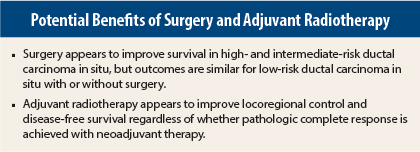Two separate retrospective studies have further refined our understanding of the respective contributions of surgery and radiotherapy in the treatment of breast cancer. However, these studies are not definitive, and “gold standard” trials are needed to arrive at definitive recommendations. Both abstracts were presented at the 2015 ASCO Annual Meeting and were discussed at the Best of ASCO® 2015 by Steven Isakoff, MD, of Massachusetts General Hospital, Boston.
A retrospective review of a large database suggested that surgery improves survival in intermediate- and high-grade ductal carcinoma in situ but does not affect survival in low-grade ductal carcinoma in situ. It may be possible to forgo surgery in low-grade ductal carcinoma in situ, but further prospective study is needed.
A retrospective meta-analysis found that adding adjuvant radiation therapy to neoadjuvant treatment improves outcomes in women with operable and nonoperable breast cancer, regardless of whether they achieve pathologic complete response to neoadjuvant therapy. In that study, women with and without pathologic complete response who did not receive radiation therapy had worse outcomes.
Surgical Management of Ductal Carcinoma in Situ
Widespread use of mammography has led to increased detection of ductal carcinoma in situ. Currently, about 60,000 new cases of ductal carcinoma in situ are reported each year in the United States. An estimated 40% to 85% of these cases are low grade.
Current management of ductal carcinoma in situ is lumpectomy with radiation or mastectomy. The magnitude of the survival benefit of surgery in ductal carcinoma in situ is not well known. Yasuaki Sagara, MD, Research Fellow in Surgery at Brigham and Women’s Hospital in Boston, and coauthors designed a study to explore whether surgical management improves survival in women with low-grade ductal carcinoma in situ.
The study was based on more than 96,000 cases of ductal carcinoma in situ entered in the Surveillance, Epidemiology, and End Results (SEER) database between 1988 and 2011. Of them, 57,000 cases met the inclusion criteria; 56,053 cases (98%) were managed surgically, and, for various reasons, 1,169 (2%) did not undergo surgery. These two cohorts of patients were compared.
The authors found that nonsurgically managed patients had a higher proportion of low-grade ductal carcinoma in situ and did not receive radiation therapy. Those treated with surgery were more likely to have high-grade ductal carcinoma in situ and to receive radiation therapy.
At a median follow-up of 72 months, 576 breast cancer–specific deaths (1%) were reported; 3,600 deaths from other causes (6.4%) were also reported.
Overall, surgically managed patients had significantly improved 10-year breast cancer–specific survival compared with the nonsurgical group: 98% vs 93%, respectively (P < .001). Overall survival was 89% vs 83%, respectively. Nuclear grade was associated with a survival benefit in the surgery group (P = .0003).
“The main message of this study is that there was no difference in 10-year breast cancer–specific survival for low-grade ductal carcinoma in situ patients who did or did not have surgery. These are relatively small numbers, but there is no discernible difference. But there is a difference in breast cancer–specific survival in the high-grade group favoring surgery,” said Dr. Isakoff.
“We perform surgery in ductal carcinoma in situ to exclude the presence of invasive cancer and to reduce the likelihood of developing invasive cancer. At the time of surgery, about 20% to 25% of patients with ductal carcinoma in situ are upstaged. Radiotherapy after surgery reduces the risk of invasive recurrence in low-grade ductal carcinoma in situ from 30% to 12%; 7.5% of recurrences in low- or intermediate-stage patients are actually invasive cancer. There is a linear path from ductal carcinoma in situ to increased risk of invasive cancer and then increased risk of mortality,” he continued.
An ongoing, prospective, randomized trial is currently addressing the issue of whether low-risk ductal carcinoma in situ can be safely treated without surgery. Called LORIS, the study is comparing surgery vs active monitoring in patients with low-risk ductal carcinoma in situ.
Radiotherapy Post Neoadjuvant Therapy
It is controversial whether to incorporate response to neoadjuvant therapy into decision-making regarding the addition of adjuvant radiotherapy for patients with breast cancer. A pooled analysis of three GEPAR trials (GeparTrio, GeparQuattro, and GeparQuinto) was undertaken to address this question.
“Local recurrence rates after neoadjuvant and adjuvant chemotherapy have been shown to be similar if adequate local therapy is performed. Treatment response to neoadjuvant therapy is considered prognostic,” Dr. Isakoff told listeners.
The study, which was reported at the 2015 ASCO Annual Meeting by David Krug, MD, of the University Hospital, Heidelberg, Germany, suggests that adjuvant radiotherapy should be added regardless of whether patients achieve pathologic complete response or not.
The pooled analysis included 3,370 patients with operable and nonoperable breast cancer for whom there were available data on the use of radiotherapy (57% of a total of 5,780 patients). Locoregional recurrence was defined as recurrence in the breast, chest wall, or regional lymph nodes.
At a median follow-up of 50.3 months, the overall recurrence rate was 8.8%. Five-year locoregional recurrence-free survival was 89.6% with radiotherapy vs 81.8% without (P < .004). Five-year disease-free survival was 74.5% vs 66.7%, respectively (P = .087).
“The top-line result is the general benefit of radiotherapy in locoregional recurrence and disease-free survival,” Dr. Isakoff said. “It gets more interesting when you look at subgroup results. Patients with pathologic complete response still had improvements with radiotherapy, and there was also an improvement with radiotherapy in patients who did not achieve pathologic complete response. The greatest benefit was observed in patients who had pathologic complete response and were node-negative after neoadjuvant therapy.”
For those who achieved pathologic complete response, 5-year locoregional recurrence-free survival was 94.7% with radiotherapy vs 85.8% without (P = .043); 5-year disease-free survival was 86.0% vs 60.3%, respectively (P = .004).
For those without pathologic complete response, 5-year locoregional recurrence-free survival was 88.4% with radiotherapy vs 81.1% without radiotherapy (P = .030); 5-year disease-free survival was 71.7% vs 67.4%, respectively (P = .519).
Multivariate analysis adjusted for baseline parameters, tumor stage, and pathologic complete response showed that radiotherapy was an independent risk factor for locoregional recurrence-free survival (P = .038) but not for disease-free survival (P = .728).
“Radiotherapy is an independent prognostic factor for locoregional recurrence and disease-free survival after neoadjuvant therapy. We still don’t know which patients can avoid radiotherapy. We have to take these data with a grain of salt. Information on radiotherapy was available for only 57% of patients in these three trials. The three studies had different characteristics, making cross-study comparisons difficult,” Dr. Isakoff stated.
Additionally, the no-radiation group in the mastectomy patients included only 151 patients. A multivariate analysis found that radiotherapy also predicted locoregional recurrence in these patients but not disease-free survival.
An ongoing NSABP/RTOG study should shed more light on this issue. That study includes patients with positive lymph nodes before treatment who undergo randomization to receive postmastectomy radiotherapy or not or—in the case of breast-conserving surgery—to whole-breast irradiation with or without regional nodal irradiation.
“This study should help decide which patients should be treated with radiotherapy and whether radiotherapy can be avoided if the patient achieves pathologic complete response after neoadjuvant therapy,” he said.
“The data from the GEPAR meta-analysis suggest that at the moment, treatment should be based on prechemotherapy characteristics,” Dr. Isakoff commented. ■
Disclosure: Drs. Sagara and Isakoff reported no potential conflicts of interest. Dr. Krug has received travel expenses from Accuray.
References
1. Sagara Y, et al: 2015 ASCO Annual Meeting. Abstract 1006. Presented May 29, 2015.
2. Krug D, et al: 2015 ASCO Annual Meeting. Abstract 1008. Presented May 29, 2015.



